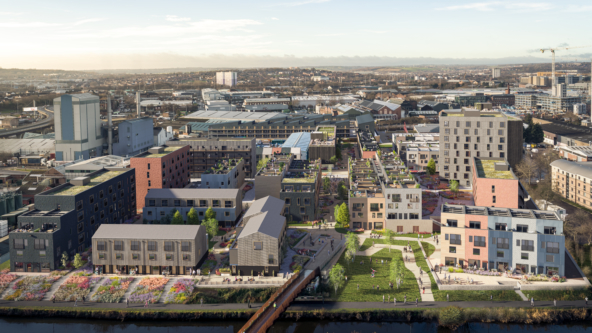The UK’s three leading primary care property investors have pledged over £3billion to support the development of the NHS’s primary care estate and meet recommendations set out in the Government backed Naylor Review. The Primary Care Buildings Pledge, made today by Primary Health Properties plc (PHP plc), Octopus Healthcare (Adviser to the MedicX Fund )and Assura plc, could fund as many as 750 state of the art primary care centres through 3rd party development (3PD) across the country over the next parliament.
Sir Robert Naylor, the government’s estates tsar, welcomed the pledge:
“It is encouraging to see the private sector step forward to play their part in meeting the recommendations set out in my review published earlier this year – with a credible plan and offer on the table for the NHS and Government to respond to.
“Investment to improve and grow a fit-for-purpose NHS estate is absolutely critical after years of underinvestment. Capital investment for refurbishments has tended to focus on big hospitals but it is crucial this is done in tandem with improvements to the primary care estate. Only with this will we have a system that treats people effectively in the community to prevent hospital admissions and further strain on already stretched secondary care services.
“The NHS needs a workable model for estates investment that sees genuine value delivered in the long-term – the 3PD proposition put forward is clearly a step in the right direction.”
In his review, Sir Robert Naylor argued that current investment levels are insufficient to fund the necessary transformation in care and maintain the NHS estate. He estimated that the 44 Sustainability and Transformation Plans (STPs) required a capital investment of £10bn, and should be funded through a three way split of NHS property disposals, private capital investment (for primary care) and allocations from the Treasury.
The importance of a fit-for-purpose NHS estate was highlighted during the election with the recommendations of the Naylor Review endorsed in the Conservative Party’s 2017 manifesto, where it promised the largest investment in buildings ever seen by the NHS.1 New facilities are vital for delivering the ambitions of the Five Year Forward View to grow the primary care workforce, extend access to general practice and to deliver a wider range of services closer to home for patients.
The group argues that the case for a private sector partnership to support the development of new primary care buildings is clear. According to a recent BMA survey, 40% of GPs feel their current facilities are inadequate for delivering services, 70% feel their premises are too small to deliver additional services and 52% said their premises had received no investment or refurbishment in the last 10 years.
The three investors are meeting with Government departments and NHS England to build a roadmap for collaboration with the Government so it can secure the future primary care infrastructure it needs.
Who pays and how will it deliver value for money for the NHS and patients?
- Independently decided rent costs for the NHS: To service this investment would require less than £200m of rent per annum from the NHS – rent which would be set for the NHS independently, at market rate, by District Valuer Services (part of the Valuation Office Agency which in turn is an executive agency sponsored by HMRC). This would be additional expenditure on top of what is currently spent on primary care estates rent by the NHS.
- Value for money: This represents an increase on current rental spend but importantly, would provide fit-for-purpose buildings that would help reduce pressure across the system by facilitating improved care in the community and the more efficient delivery of services. More than £270m per annum could be accrued from the use of modern multi-functional care premises by reducing the non-urgent use of A&E departments, removing the pressure on walk-in centres, and increasing GP care for the elderly2
- Protecting the NHS from cost-escalation risk: 3PD eliminates the risk of escalated public spending – in this case to benefit the NHS. Notably, 3PD differs from PFI in several critical ways: primarily, the key differential is that under PFI the whole asset is paid for plus interest by the NHS, whereas under 3PD the investors (in this case PHP plc, Octopus Healthcare and Assura plc) take the residual liability risk of the land and buildings and would commit further capital to modernise the existing estate. In practice, this means 3PD investors do not charge additional fees back to the tenants for maintenance.
- Better care for patients across the UK: Hospitals, especially A&E services, would face less pressure as fit-for-purpose facilities allow for the expansion of community and primary care workforce, alongside the use of new digital technologies to support patient care. New medical centres could be distributed across the country to support all 44 STPs to reconfigure their services
Commenting, David Austin, PHP plc Property Director, said:
“The primary care estate in the UK is at a crossroads; it’s clear that facilities currently in use by many GPs are not fit for purpose, and new avenues for investment are available but need to be explored by the NHS and Government if it is to effectively deliver the ambitions of the Five Year Forward View”
Commenting, Tim Meggitt, Octopus Healthcare Director, said:
“We are delighted to be making today’s pledge as it is the first substantive step by the private sector to activate Sir Robert’s vision. This investment in the primary care estate could ensure that government priorities of delivering necessary efficiency savings and keeping people out of costly hospital wards and in the community are met.”
Commenting, Jonathan Murphy, CEO of Assura plc, said:
“There’s enormous potential to help STPs move forward on their considerable estates challenges, and – as Sir Robert recommends – to make sure private capital is used to its full potential to improve the primary care buildings in which patients are diagnosed and treated. It is going to take significant funding, expertise and experience to support GPs with the premises on which transformation can be built, and we’re ready to help.”
Click here to read more in our Primary Care Buildings paper
Notes
1 p67 “Forward together: the Conservative manifesto” https://www.conservatives.com/manifesto
2 http://www.bpf.org.uk/sites/default/files/resources/Unlocking-Investment-in-Primary-Healthcare-Infrastructure.pdf


